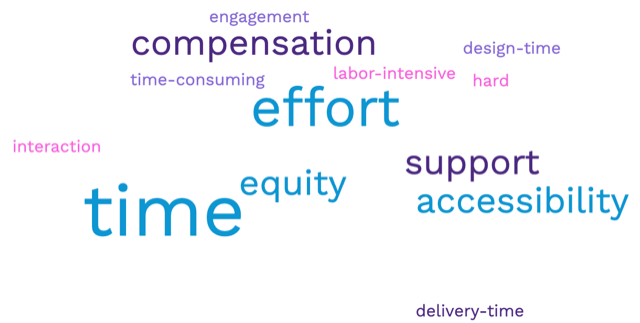This blog post provides an overview of the new self-paced workshop, 3-Steps for Transitioning to HyFlex. In addition, the advantages and disadvantages of self-paced learning are highlighted. Why self-paced learning is a good fit for teacher training is also included in this blog post. Rolling enrollment registration starts now. Workshops open May 1, 2023. Complete at your own pace.
About the 3 Steps Workshop
The 3-Steps for Transitioning to HyFlex Workshop is now offered as a self-paced session. The workshop provides a structure for moving your course from one delivery mode to another. You can develop at the same time for all modes you will offer per course. This is efficient since you work on all modalities at one time rather than on two or more separate courses. Importantly, developing multiple modes at the same time is effective. Alignment with outcomes is more likely to be consistent since you are working on the assessment and learning activities that flow from the same outcomes at the same time.
By now many educators know the value of the HyFlex learning environment. The principle of learner choice puts the learner in control of where they learn. Before HyFlex, learners often had to choose between work, family, and school when life happened. For example, an out-of-town work commitment, a sick child, or other responsibilities. Weather events and pandemics disrupted school continuity. In a true HyFlex environment, there are no longer snow days.
Teachers who have not yet offered classes in the HyFlex format may be reticent to do so. They are concerned about how much time it may take to develop the course, they are concerned about classroom infrastructure and technology support. They are apprehensive about putting more on their plate without any time or monetary compensation.

Figure 1. Faculty Concerns about HyFlex
Why Self-paced Learning (SPL)?
Self-paced is an approach to learning that is effective for promoting learner autonomy, motivation, and engagement. While the online asynchronous classroom is more flexible than the online synchronous class or in-person, self-paced learning adds another flexibility aspect – duration or pace. The asynchronous online class is offered both at a different location and at a different time. Peers and the teacher are not required to interact in real-time. Self-paced learning can promote better completion since learners who need more or less time to complete work can choose when to work, where to work, and when work is due. This helps maintain class continuity during planned and unplanned events. The traditional 16-week course duration has been in place for decades until recently. It is designed for students to absorb and understand the material at the same pace. However, students learn at different rates. Some students may grasp the material quickly while others may need more time to fully understand the concepts. In past, when self-paced learning was designed, it was like a correspondence course. Set it and forget it with little facilitator interaction or integrated brain-based learning (metacognitive) strategies.
Self-paced courses can permit longer or shorter completion. Benefits of a flexible pace include:
♦Customization can help learners save time which contributes to higher motivation. Learners can tailor their learning experience to their specific needs and preferences. They can focus on topics they find challenging and quickly review or skip topics they already know.
♦ Active learning is a critical part of self-paced learning. Active learning includes a range of interactive activities like polling (quizzes), simulations, games, and similar strategies to engage learners more deeply with course content. Employing technology facilitates interleaving and repeating information to promote retention. Active learning promotes attention and motivation which also promotes information retention.
♦Accountability and self-regulation can develop during self-paced learning since learners are required to take responsibility for their learning. You might need to guide learners initially to help them to develop the needed skills. Over time, you check in less frequently as they put their time-management systems in place. A well-structured and designed course should provide built-in reminders and guides to keep learners progressing.
♦Immediate Feedback including a mix of immediate system/auto grading and feedback for assignments and activities with instructor and peer feedback and grading keeps learners on track, engaged, and progressing. When learners must wait for feedback to improve or adjust their learning behavior and strategies, they may slow down or even stop working. SPL design should include immediate feedback.
Why Self-paced Learning for Teachers?
A continuous learning and improvement cycle can lead to positive outcomes for both teachers and learners. Quality courses require continuous improvement to ensure increased student success. Similarly, teacher professional development is the process of continuous learning and growth to improve instructional practices. In other words, professional development is part of a closed loop. Teachers improve their skills thus improving the course, and learners are more motivated and engaged which in turn motivates teachers to continue improving their course delivery and design. However, teachers are like learners regarding unplanned events that interrupt their schedules. Many are busier now than they were pre-COVID. Attending a workshop is a big decision. Adding flexibility to your training sessions makes it more likely people faculty/teachers will enroll and complete your training. Like learners, teachers appreciate and need control over their schedules. When there are no or few incentives to participate or complete professional development, the sessions need to be relevant, convenient, and concise. When possible, training sessions need to offer time-saving tips and strategies. Useful training is offered just-in-time or as proximate as possible when it is needed. For teachers, self-paced learning can also be personalized and flexible. A quality SPL experience considers the challenges of self-paced learning. These include:
♦ Lack of interaction between other teachers and the facilitator may trigger teachers to lose interest in the workshop or course.
♦ Self-motivation and discipline is often higher for teachers than for their students, but still a challenge. Professional development completion rates are often low and the application of the skills learned is even lower due to competing projects and obligations.
♦ Infrequent or late feedback can cause teachers to slow down and eventually stop working.
About the SPL 3-Steps for Transitioning to HyFlex Workshop

During the project-based workshop, you will experience the challenges of designing for multiple delivery modes offered simultaneously. You will use the following steps to create a HyFlex bimodal, lesson:
♦ Document
♦ Review (& Revise)
♦ Complete (& Extend)
The HyFlex Learning Community Course Quality Rubric (HLCCQR) is now an optional part of the workshop to help you review your lesson. After the workshop concludes, content, posted activities (containing the discussions and work of the participants), and all workshop resources remain available to support ongoing implementation and expanded faculty development efforts for one (1) year.
Bonus
In addition to the three foundational projects, there are three optional activities to facilitate lesson planning and interaction and engagement. Numerous just-in-time readings on course design topics are included in the workshop to help you develop your lesson.
Registration Information
Enroll now. There are rolling start dates. You may switch from instructor-led to self-paced as needed. Or, you may switch from a self-paced to a scheduled instructor-led as desired. Individual registrations: $125 per person, two or more registrations from a single institution purchased in a single order: $95 each. Enter code: 3STEPS95 for the discount.Please contact us for more information or visit the workshop website.
Author
-

Recently retired from the LCTCS. Served as the Dean of Global Online at Fletcher TCC and Dean of DLIT at Delgado CC. Is a HyFlex Learning Community Advisor and a freelance ID.
View all posts